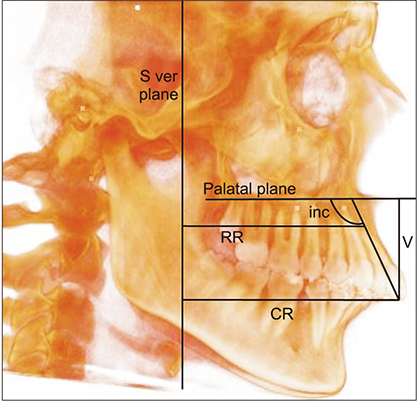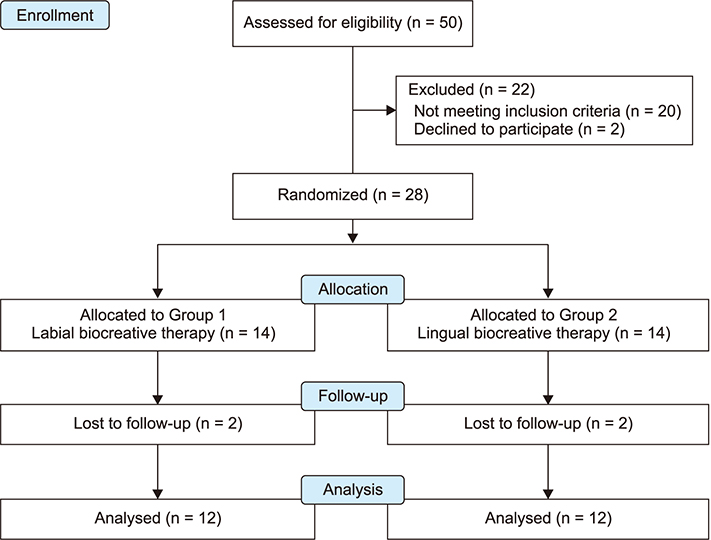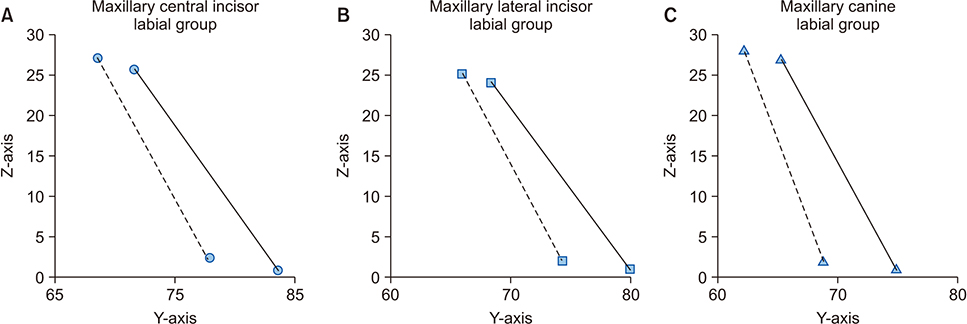Korean J Orthod.
2019 Nov;49(6):381-392. 10.4041/kjod.2019.49.6.381.
Type of tooth movement during en masse retraction of the maxillary anterior teeth using labial versus lingual biocreative therapy in adults: A randomized clinical trial
- Affiliations
-
- 1Department of Orthodontics, Faculty of Dentistry, Ain Shams University, Cairo, Egypt. maismedhat@asfd.asu.edu.eg
- 2Faculty of Dentistry, Ain Shams University, Cairo, Egypt.
- KMID: 2464201
- DOI: http://doi.org/10.4041/kjod.2019.49.6.381
Abstract
OBJECTIVE
The objective of this two-arm parallel trial was to compare the type of tooth movement during en masse retraction of the maxillary anterior teeth using labial versus lingual biocreative therapy.
METHODS
Twenty-eight subjects were randomized in a 1 : 1 ratio to either the labial or lingual group. En masse anterior retraction was performed using labial biocreative therapy in group A and lingual biocreative therapy in group B. Cone beam computed tomography scans were taken before and after retraction and the primary outcome was the type of tooth movement during anterior retraction. Data were analyzed using paired t-tests for comparisons within each group and independent-sample t-test for comparison of the mean treatment changes between the two groups.
RESULTS
Significant differences were found between the two groups in relation to the type of tooth movement (labiolingual inclination of the central incisor; mean difference, 5.85 ± 1.85°). The canine showed significant distal tipping in the lingual group (mean difference, 6.98 ± 1.25°). The canine was significantly more intruded in the lingual group (mean difference, 1.67 ± 0.49 mm). Good anchorage control and significant soft tissue changes occurred in both groups. No serious adverse effects were detected.
CONCLUSIONS
With a 10-mm retraction hook, the labial biocreative technique with the reverse curve overlay provided anterior retraction with good torque control, while in the lingual group, anterior retraction occurred with controlled tipping movement with significant distal tipping and intrusion of the canine (trial registration: The trial was registered at ClinicalTrials.gov [NCT03239275]).
Figure
Cited by 1 articles
-
Root proximity of the anchoring miniscrews of orthodontic miniplates in the mandibular incisal area: Cone-beam computed tomographic analysis
Do-Min Jeong, Song Hee Oh, HyeRan Choo, Yong-Suk Choi, Seong-Hun Kim, Jin-Suk Lee, Eui-Hwan Hwang
Korean J Orthod. 2021;51(4):231-240. doi: 10.4041/kjod.2021.51.4.231.
Reference
-
1. Antoszewska-Smith J, Sarul M, Łyczek J, Konopka T, Kawala B. Effectiveness of orthodontic miniscrew implants in anchorage reinforcement during en-masse retraction: a systematic review and meta-analysis. Am J Orthod Dentofacial Orthop. 2017; 151:440–455.
Article2. Sung EH, Kim SJ, Chun YS, Park YC, Yu HS, Lee KJ. Distalization pattern of whole maxillary dentition according to force application points. Korean J Orthod. 2015; 45:20–28.
Article3. Lee KJ, Park YC. The biomechanics of miniscrews: from single-tooth control to total-arch movement. In : Burstone CJ, Choy K, editors. The biomechanical foundation of clinical orthodontics. Chicago: Quintessence Publishing;2015. p. 435.4. Chung KR, Kim SH, Kook YA, Son JH. Anterior torque control using partial-osseointegrated mini-implants: biocreative therapy type I technique. World J Orthod. 2008; 9:95–104.5. Chung KR, Kim SH, Kook YA, Choo H. Anterior torque control using partial-osseointegrated mini-implants: biocreative therapy type II technique. World J Orthod. 2008; 9:105–113.6. Mo SS, Kim SH, Sung SJ, Chung KR, Chun YS, Kook YA, et al. Factors controlling anterior torque with C-implants depend on en-masse retraction without posterior appliances: biocreative therapy type II technique. Am J Orthod Dentofacial Orthop. 2011; 139:e183–e199.
Article7. Burstone CJ. The segmented arch approach to space closure. Am J Orthod. 1982; 82:361–378.
Article8. Chung KR, Kook YA, Kim SH, Mo SS, Jung JA. Class II malocclusion treated by combining a lingual retractor and a palatal plate. Am J Orthod Dentofacial Orthop. 2008; 133:112–123.
Article9. Chung KR, Cho JH, Kim SH, Kook YA, Cozzani M. Unusual extraction treatment in Class II division 1 using C-orthodontic mini-implants. Angle Orthod. 2007; 77:155–166.
Article10. Chung KR, Jeong DM, Park HJ, Kim SH, Nelson G. Severe bidentoalveolar protrusion treated with lingual Biocreative therapy using palatal miniplate. Korean J Orthod. 2010; 40:276–287.
Article11. Kim SH, Hwang YS, Ferreira A, Chung KR. Analysis of temporary skeletal anchorage devices used for en-masse retraction: a preliminary study. Am J Orthod Dentofacial Orthop. 2009; 136:268–276.
Article12. Kim JS, Kim SH, Kook YA, Chung KR, Nelson G. Analysis of lingual en masse retraction combining a C-lingual retractor and a palatal plate. Angle Orthod. 2011; 81:662–669.
Article13. Mo SS, Kim SH, Sung SJ, Chung KR, Chun YS, Kook YA, et al. Factors controlling anterior torque during C-implant-dependent en-masse retraction without posterior appliances. Am J Orthod Dentofacial Orthop. 2011; 140:72–80.
Article14. Mo SS, Kim SH, Sung SJ, Chung KR, Chun YS, Kook YA, et al. Torque control during lingual anterior retraction without posterior appliances. Korean J Orthod. 2013; 43:3–14.
Article15. Jee JH, Ahn HW, Seo KW, Kim SH, Kook YA, Chung KR, et al. En-masse retraction with a preformed nickel-titanium and stainless steel archwire assembly and temporary skeletal anchorage devices without posterior bonding. Korean J Orthod. 2014; 44:236–245.
Article16. Jang HJ, Roh WJ, Joo BH, Park KH, Kim SJ, Park YG. Locating the center of resistance of maxillary anterior teeth retracted by Double J Retractor with palatal miniscrews. Angle Orthod. 2010; 80:1023–1028.
Article17. Seo KW, Kwon SY, Kim KA, Park KH, Kim SH, Ahn HW, et al. Displacement pattern of the anterior segment using antero-posterior lingual retractor combined with a palatal plate. Korean J Orthod. 2015; 45:289–298.
Article18. Tominaga JY, Ozaki H, Chiang PC, Sumi M, Tanaka M, Koga Y, et al. Effect of bracket slot and archwire dimensions on anterior tooth movement during space closure in sliding mechanics: a 3-dimensional finite element study. Am J Orthod Dentofacial Orthop. 2014; 146:166–174.
Article19. Sung SJ, Jang GW, Chun YS, Moon YS. Effective en-masse retraction design with orthodontic mini-implant anchorage: a finite element analysis. Am J Orthod Dentofacial Orthop. 2010; 137:648–657.
Article20. Bourauel C, Drescher D. Retraktion der oberen Schneidezähne mit pseudoelastischen Behandlungselementen-Rechnerische und biomechanische Prüfung sowie klinische Anwendung. J Orofac Orthop. 1994; 55:36–44.
Article21. Melsen B, Fotis V, Burstone CJ. Vertical force considerations in differential space closure. J Clin Orthod. 1990; 24:678–683.
- Full Text Links
- Actions
-
Cited
- CITED
-
- Close
- Share
- Similar articles
-
- Effectiveness of anchorage with temporary anchorage devices during anterior maxillary tooth retraction: A randomized clinical trial
- Finite element analysis of the effects of different archwire forms and power arm positions on maxillary incisors in en masse retraction using fixed lingual orthodontic appliances
- Force changes associated with differential activation of en-masse retraction and/or intrusion with clear aligners
- Comparison of inclination and vertical changes between single-wire and double-wire retraction techniques in lingual orthodontics
- Severe bidentoalveolar protrusion treated with lingual Biocreative therapy using palatal miniplate









